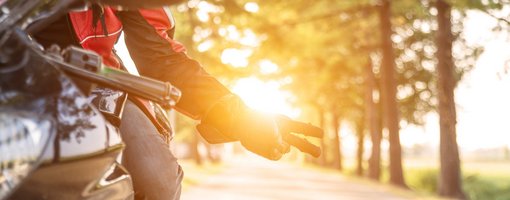Driving licence category A1
The "small" motorcycle driving licence
While you are allowed to drive a scooter with an AM category driving license, the A1 category driving license is your entry into the world of motorcycles. Both driving licences can be taken at the age of 16. With the A1 driving licence, you automatically also get the AM driving licence. This allows you to drive the motorcycles with a "small", i. e. - a cubic capacity of up to 125 ccm. The maximum power is 11kW.

Find your motorcycle driving school
Would you like to slowly take the step into the world of motorcycles? Then look here for a suitable driving school in your area to get the A1 category driving licence.
General information on the A1 driving licence
- Minimum age: 16 years. You can take the theory test 3 months before your birthday, the practical test 1 month before your birthday.
- Documents: A ision test, first aid course and biometric passport photo.
- Time limit: none. However, the driving license is only valid for 15 years. After this time you must apply for a new document, which will then be valid for another 15 years again.
- Prerequisites: For the A1 driving license you must have successfully completed the theory- and practical test.
- This driving license category is automatically assigned to you with the A1 driver's license: AM.
- You are allowed to drive this with your A1 driving licence: Motorcycles with a displacement of max. 125 ccm, a power of max. 11 kW and a ratio of power to weight of max. 0.1 kW/kg. You may also drive three-drive motor vehicles (e.g. trikes) with a cubic capacity of more than 50 ccm (for combustion engines) or a design speed of more than 45 km/h. However, the power is limited to max. 15 kW.
- Special feature: The A1-license is the first stage of motorcycle licences. This is followed by A2-license with a minimum age of 18 years and A-license with at least 20 years. The sense of the levels is that one slowly increases oneself and cautiously approaches the increased engine power.

All you need to know about A1 training
In your theoretical driving licence training, you will be familiarised with the basics of motorcycling and traffic regulations. The theoretical training includes the basic material and the additive. The basic material includes the general test material, which is valid for all driving licence categories. The additive contains the special requirements of the respective vehicle category.
For the basic substance in Category A1, you must visit a total of 12 lessons for 90 minutes to be admitted to the theory test. If you already have a driving licence, the basic substance is reduced to 6 lessons.
In addition, you must have attended at least 4 lessons of 90 minutes for the additive. In these hours, unlike in the basic substance, it is about special motorcycle contents of the training. They are obligatory for the acquisition of a driver's licence.
The following applies: If you have problems with a certain topic, e.g. the right of way rules, you may, of course, also listen to the material a second time in class. The hours mentioned above are the minimum prescribed hours.

Practice
In your motorcycle lessons, you will familiarize yourself with your machine and traffic regulations. How many of these lessons you need depends entirely on your ability and learning progress. One driving lesson always lasts 45 minutes. A prescribed number of special rides must be completed. So you have to do in Category A1 at least 5 training hours on Federal or country roads, 4 training hours on highways and 3 training hours in dawn or darkness.
When you are ready for the test, your instructor will let you know and give you valuable tips for your test drive in a final lesson. Have a look at difficult places from your test area in the Drivers Cam App.

Tip
A good driving school won't let you get on your bike without safe protective clothing but will provide you with it. For hygienic reasons, put on a balaclava or buy a well-fitting helmet, which you will need afterwards anyway. Your driving school will also be happy to give you tips for buying your own protective clothing.